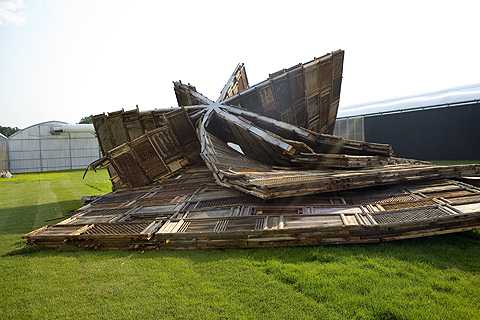Documenta,
Jun 16, 2007 - Sep 23, 2007
Kassel, Germany
Documenta 12
by Kirsten Einfeldt
The most spectacular news stemming from this Documenta arose by chance. Not even a week had elapsed after the opening of the world’s most important contemporary art exhibition when one of the most popular sculptures in Kassel simply collapsed. Template, a strange construction made up of doors and shutters taken from old Chinese houses by artist Ai Wei Wei (1957), stood in front of the Aue-Pavilion, a "crystal palace" built by the French architects Lacaton and Vassal. The 12-meter sculpture did not resist one of this summer’s strongest storms in the German countryside and fell - creating a more elegant result than the original sculpture, a circumstance that ended up exciting even the artist himself. "It’s better than before", commented Ai on the transformation of his work. "Now the power of nature is in evidence, and art only becomes beautiful through this kind of emotions." Template was not rebuilt, but now, more than before, it provides a possible answer to what "pure life" can be, one of the curatorial questions posed by this Documenta - the human impossibility of influencing or resisting certain situations, and the "life of its own" that a work can acquire. The form resulting from the collapse of Template - which gave the impression of being a dissolute constructivist sculpture --also offers an answer to another subject chosen by the curator and artist Roger M. Buergel and his companion Ruth Noack for the exhibition: "Is modernity our antiquity?" Various works in Kassel, among them Template, support that theory, but none so much as Ai's piece took Buergel's third question, "what to do?" to such ad absurdum precision. In Template’s case the work’s involuntary development boycotted the pedagogically ambitious concept of educating and training the public through guided tours and awareness-creating processes. Conversely, the work’s failure gave rise to productive, even emotional, dynamics between the work, spectators and the creator himself. There can be no doubt that the main achievement of this Documenta is its almost unconditional emphasis on the artworks themselves, which emphasized different internal questions on the process of creating art: the concerns over materials, techniques, motives and iconography of artists on all continents. Several approaches also questioned geopolitical developments and dealt with social issues, such as the recording of change in today’s China, as exemplified by the observation of one of Beijing’s main streets and embodied as a horizontal narrative on cloth in Recording Chang’an Street (2006) by the Chinese artist Lu Hao (1969). The reference to ethnic issues was present in the installation criticizing the European concept of culture by the Benin artist Romualdo Hazoumé (1962) and migration issues, as in the Goter series (2002/2003) by Palestinian photographer Ahlam Shibli (1970), which speaks of the problems stemming from population transfers in the Near East. Prior to the exhibition, however, in a small text published months prior to its opening - an example of the scant information Buergel offers on his theoretical standpoint - the director of Documenta 12 made his idea clear: "The exhibition is more than anything an exhibition, that is to say, without a package of information to inform us more or less academically on local relationships; because if one takes that road, art becomes illustrative."(1) Unlike him, his predecessor, the Nigerian curator and artistic director of Documenta 11, Okwui Enwezor, had sought to present an exhibition with a very strong focus on the worldwide political and social situation. Enwezor summed up his aspirations for Documenta 11 as" a reflection of the alternative production of knowledge through art". In Buergel’s view, Enzewor’s socio-political concerns were, above all, a statement of the crisis of form in art through the processes of globalization. Encompassin
|













